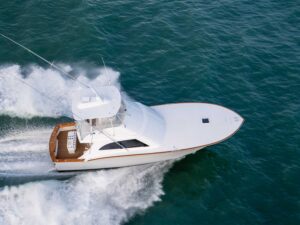
Capt. Billy Chapman, Fishbone, Islamorada, Florida

There has been a fair amount of discussion on this topic, especially this past year. Some believe it’s unfair, but to me, it’s the next best thing since sliced bread. No, I don’t have one, but yes, I sure want one! I understand how it can be perceived as unfair, especially when you have the ability to scan an area up to almost a mile, or even to track a fish all the way up until lines in. So where do we draw the line? I have some advantages that the next guy might not have, such as a full tower and satellite overlay. The bright side is this: Marine electronics are always changing, and in a few years, there will be another “next best thing.”
Watch: A belly-strip teaser is a great way to raise marlin and sailfish. Learn to rig one here.
Capt. Chris Hood, It Just Takes Time, Orange Beach, Alabama

No. Omnidirectional sonar is just another tool available to those who are trying to achieve success. Everyone in the fleet has the same opportunity to get a sonar installed in their boat, so it’s just a matter of whether the owner is willing to make the investment in order to increase the odds of his team’s success. It’s really no different than having the fastest boat in the fleet, or even the one with the most range. At the end of the day, you can mark as many blue marlin as you want, but the fact remains that you still have to get them to bite.
David Finkelstein, Owner, Miss Behavin, Houston, Texas

No different than size or speed, commercial sonar is a tool—each of which changed the game by leaps and bounds in the past 20-plus years. Twenty-five knots used to be fast; a 50-footer used to be the perfect platform. But now, if you aren’t cruising at 35 knots on your 70-footer, you’re standing still. Faster and bigger got us to the fish before these sonars came into the picture. If you want to play, and you think it gives you an advantage, then get a sonar. If you don’t have one and think you are at a disadvantage, then don’t fish the tournament. You still have to get the bite and catch the fish, and sometimes they just don’t like what you’re offering—sonar or not.
Read Next: Read our review of the new Duffie 64.
Capt. Chucky Moore, Artemis, Charleston, South Carolina

The sonar is absolutely a game-changer, but not in every situation. There are a lot of misconceptions about its capabilities, most coming from those who don’t have it. In deep water when targeting blue marlin, the omni is a weapon, but in shallow-water situations with sails, and sometimes whites, you lose range and it gets more complicated. Part of using this tool is knowing when to put it back in the box because it can be distracting at times. You don’t need it to be effective, and you definitely don’t need it to win. Those who are doing well with it were successful before it.
This article originally appeared in the March 2022 issue of Marlin.







